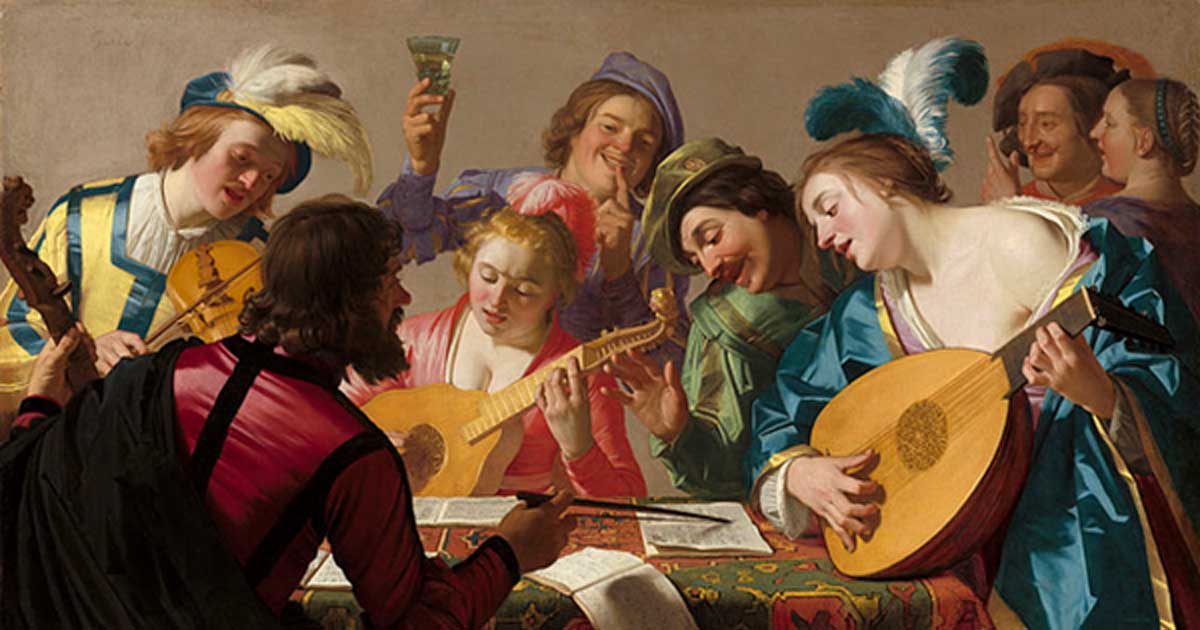Band Posters of the Renaissance: How Medieval Music Fans Showed off Their Taste
Did you once put a poster of your favorite music artist on your bedroom wall? Are there a few faded gig T-shirts in your bottom drawer? Have you ever bought an LP or CD because of the cover art?
Many music fans enjoy surrounding themselves with images that reflect their musical tastes and experiences – and the meanings and memories they carry. The music enthusiasts of Renaissance Italy were no different.

Serafino sings with lute while under attack by Cupid, title page, 1510 poetry anthology. Fondation Barbier-Mueller pour l'étude de la Poésie Italienne de la Renaissance. (CC BY SA 4.0)
Musical images appeared everywhere in Renaissance Italy, from portraits and altarpieces to dinner plates and saddle steels, from wall paintings and furniture decoration to art prints and book illustration.
Looking at these images can teach us a great deal about what people understood music to be – and what they thought music-making might achieve in their lives.
- Musical Monk: Guido of Arezzo and His Impact on the History of Music
- British Library intern finds earliest known piece of polyphonic music
- Sweet Ancient Melodies of the Ney: One of the Oldest Musical Instruments Still in Use
If you loved music in the age of Leonardo, Raphael and Michelangelo, the chances are you spent your leisure time playing the lute. And in imitating the most famous singer-songwriter (and inamorato) of the day, Serafino dell’Aquila, young men and women hoped that learning to accompany themselves singing love poems would improve their chances with the opposite sex.
Portrait of an aesthete
When sitting for the portrait painter, many chose the lute as the prop that would capture their character and present them in the best light.

‘Portrait of a Lute Player’ (c. 1600) by Annibale Carracci. (Public Domain)
Hanging your musical portrait in your best room, you’d probably hope that your friends thought you looked a bit like the ancient mythological musician Orpheus. Accordingto the myths, Orpheus was a lover so loyal that he sang his way into hell itself to rescue his wife.
Art prints showing Orpheus sitting under a tree with a lute wereall the rage in the Renaissance – you would probably have one sitting about somewhere in your study. In these images, Orpheus is singing a song so powerful that even the animals and birds are moved to tears.
Divine inspiration
Contemporary books on music andpoetry explain that this scene of Orpheus moving brute animals to tears represented persuasive eloquence, prized as a leadership quality and a sign of a good education.

‘Orpheus Charming the Animals’ (1613) by Jacob Hoefnagel. (Public Domain)
If you had the money, you’d probably have the walls of your study decorated with pictures of the ancient music-making godApollo and his Muses.
Inhabitant of themythological mountain Parnassus, where crystal fountains bubbled forth poetic inspiration, the figure of Apollo allowed you to associate your musical pastime with the immense contemporary fashion for the culture of the ancient world.
You’ll have had him represented with a modern stringed instrument (like yours), probably singing. On your study wall he leads his choir of nine music-making Muses, as they confer their divine inspiration upon your own amateur efforts.
- Song of Seikilos: Oldest Known Musical Composition Lay Hidden on a Flower Stand in Turkish Garden
- 1,000-Year-Old Lost Music Reconstructed from Ancient Manuscript
- The Mysterious Lithophones of Vietnam: Descendants of the First Musical Instruments?
Catholic tastes
Even a disreputable music-lover would attend church for Mass or Vespers at least once a week, so Catholic plainsong was part of the background hum of everyday life. It was widely thought that plainsong imitated themusic-making of the angels in heaven. By singing prayers, therefore, you could yourself attain some measure of the divine.
An old panel painting showing the Virgin and Child with music-making angels hangs in your parlor. It would be the focus of prayer and pious contemplation for the whole household, visualizing the divine encounter you would hope to achieve by singing simple sacred songs.

Bernardino Bergognone, Virgin and Child with Two Angels, 1490-95, oil on panel. (The National Gallery, London 2017)
On the other side of the parlor, your young daughter is practicing at a small keyboard instrument, a virginals, very popular in homes of all sizes. The virginals has a lid in the shape of a wonky rectangle which is often painted on the underside, so that you can see the picture when you open the instrument up to play.
Yours shows Apollo again, but this time he’s in amusical contest with a lusty goat-legged satyr. Sitting in judgement is the foolish King Midas (of “Midas touch” fame). The loser risks having his ears turned into those of a donkey, or even being flayed alive. Your daughter concentrates very hard on her scales.
Images such as these were chosen by Renaissance music fans to form a backdrop to their everyday music-making. Like the band posters on a modern bedroom wall, they bear rich witness to musical tastes and experiences, and the meanings people found in them. Delving more deeply into the stories these images tell, music historians are learning to look as well as listen to Renaissance music.
Top Image: Gerard van Honthorst's 1623 painting ‘The Concert.’ Source:Public Domain
The article ‘Band posters of the Renaissance: how medieval music fans showed off their taste’ byTim Shephard was originally published onThe Conversation and has republished under a Creative Commons license.



















